INFRAPUBIC
APPROACH FOR MALLEABLE PENILE IMPLANT
(
Download pdf )
Surgical Technique
doi: 10.1590/S1677-55382011000100012
Vol. 37 (1): 94-99, January - February, 2011
OSWALDO L. D. BERG
Sexual Medicine Clinic, Department of Urology, Hospital da Lagoa, Rio de Janeiro, Brazil
ABSTRACT
Purpose:
Today, we find that the implant of malleable prostheses still plays a
leading role in the surgical treatment of erectile dysfunction. These
may involve patients for which the cosmetic advantages of inflatable devices
are not as important as low cost, the easier use and less incidence of
mechanical complications in the malleable implants. This paper demonstrates
infrapubic approach as a technical option for this kind of implant.
Surgical Technique: It offers technical
resources and emphasizes the facility in using the method, reducing cutaneous
exposure, which diminishes risks of contamination.
Comments: As occurs in inflatable implants,
when implanting malleable prostheses through the infrapubic access, care
must also be taken regarding the possibility of lesion to the vascular-nervous
bundle. On the other hand, the approach through the dorsal surface of
the corpora cavernosa has a natural capacity for anatomical protection
of the urethra, not requiring transurethral catheterization. This benefit
is of the utmost importance when considering possible causes of per and
postoperative morbidity.
Accordingly, we can consider that the infrapubic
approach is an effective method and prevails as a technical option for
implanting malleable prostheses.
Key
words: erectile dysfunction; penile prosthesis; urologic surgical
procedures, male
Int Braz J Urol. 2011; 37: 94-9
INTRODUCTION
Since
1936 when Nikolaj Bogaraz reconstructed an amputated penis using a tubular
abdominal graft in which he inserted a section of rib cartilage, the search
for ideal materials and techniques for penile implants has been continuous.
Over the years, acrylic, polyethylene, silastic, silicon rubber and other
prostheses have been used, whether for rigid, articulated, malleable and
later inflatable of one, two or three-piece constitution (1,2).
Currently, malleable prostheses available
in the market are quite similar to each other, with a central structure
consisting of steel or silver filaments covered by two or more layers
of silicon sheath. They all offer various
modalities of size adjustment, by cutting or adding extensors to their
proximal portion.
Although today patients and surgeons prefer inflatable prostheses, some
circumstances may require the malleable implant. These may involve patients
for which the cosmetic advantages of inflatable devices are not as important
as low cost, the easier use and less incidence of mechanical complications
in the malleable implants (1-6).
With regard to the surgical technique, various
approaches have been described for implanting penile prostheses: the dorsal
subcoronal, penile proximal, longitudinal penoscrotal, transverse penoscrotal
perineal and combined incisions (7). More recently, a minimally invasive
infrapubic approach was proposed for the implant of a three-piece inflatable
prosthesis (8). The name used comes from the fact of making a single transverse
incision below the pubis. The purpose of this paper is to demonstrate
the ease of this approach for the implant of malleable prostheses.
SURGICAL TECHNIQUE
The infrapubic approach adopted in our hospital is characterized by a two to three centimeter transverse incision, approximately one centimeter from the base of the penis (Figure-1).
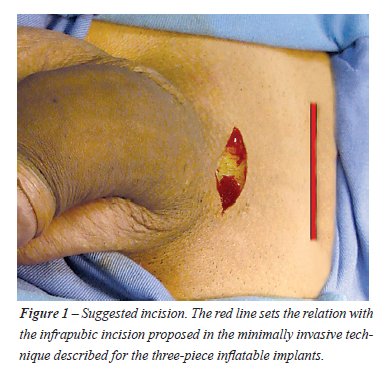
Skin and subcutaneous tissue are incised
using a conventional scalpel. Of course, care must be taken to prevent
lesions both to the suspensory ligament of the penis and to the medial
neurovascular bundle. With this in mind, the dissection is deepened using
scissors, staying at each angle of the incision and thus keeping away
from its center.
The corpora cavernosa are easily visible
by a simple thrust of the penile axis. This procedure causes stretching
and shrinkage of the corpora cavernosa, facilitating its identification
and subsequent dissection (Figure-2A).
A small longitudinal incision on the dorsal
surface of the corpus cavernous is made using a conventional scalpel between
stay sutures. The erectile tissue is pushed down using Halsted forceps
and the incision is extended to its two angles (Figure-2B).
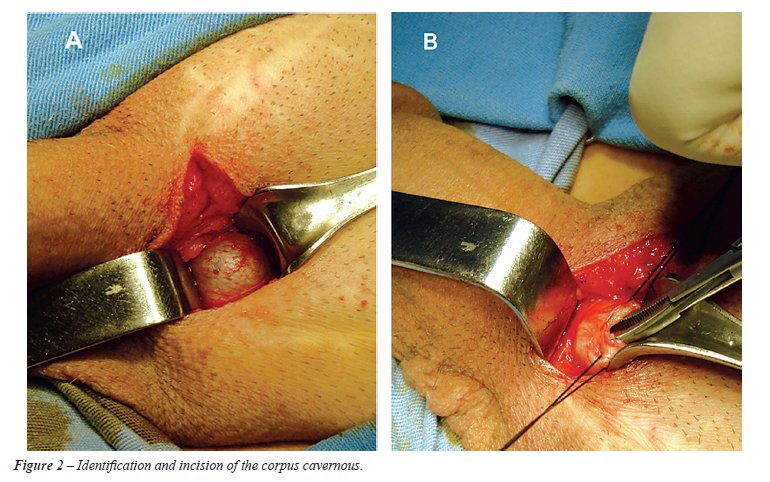
The progressive dilation of the corpus cavernous
is made using Heggar dilators in the proximal and distal directions, as
described for the other approaches.
In cases where any adherences or fibrosis of the cavernous tissue hamper
the dilation of the corpora cavernosa, several technical resources have
been proposed (9-11). In such cases, in our Hospital, this dilation is
mostly done by using a cavernotome developed by the urological unit. This
instrument is characterized by a grip with a distal cylindrical end containing
cutting spiral grooves (Figure-3).
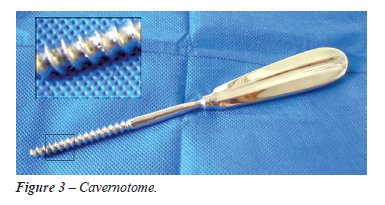
The
grooved surface is considerably more effective than that of the dilators
and file used previously. Its use consists of small delicate rotational
and longitudinal movements in order to remove the portion of the cavernous
tissue with fibrosis, pushing the rest down. It should be mentioned that
the purpose is to “file” and not “pull out” the
tissue. Extreme care must be taken when using the instrument, especially
at the start of apprenticeship.
We used the following procedure to adapt
the size of the prosthesis: first, it is introduced inverted in the proximal
direction. Next, the maximum extension of the penis will determine the
size of the prosthesis. The section of the cylinder or adaptation with
extensors is done by taking as reference the height corresponding to half
the glans. The cylinder is then removed and replaced in its normal position.
In our experience with this measuring method, when the prosthesis is introduced
into its final position, the natural angulation of the corpus cavernous,
at the base of the penis, adjusts perfectly to the prosthesis without
requiring further corrections (Figure-4).
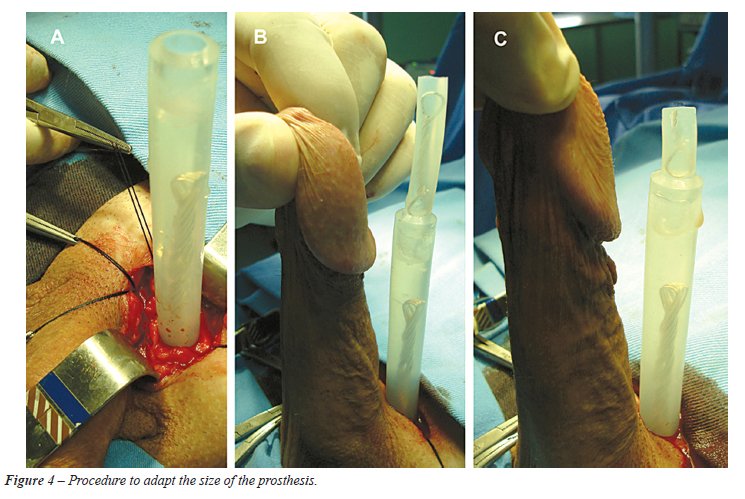
Before finally inserting the prosthesis,
the entire process described herein above is repeated on the contralateral
side.
This approach also involves the well-known
resource of the loop curvature of the cylinder that especially facilitates
its distal insertion and prevents deformities caused by angulations resulting
from nudging the metal filament (Figure-5).
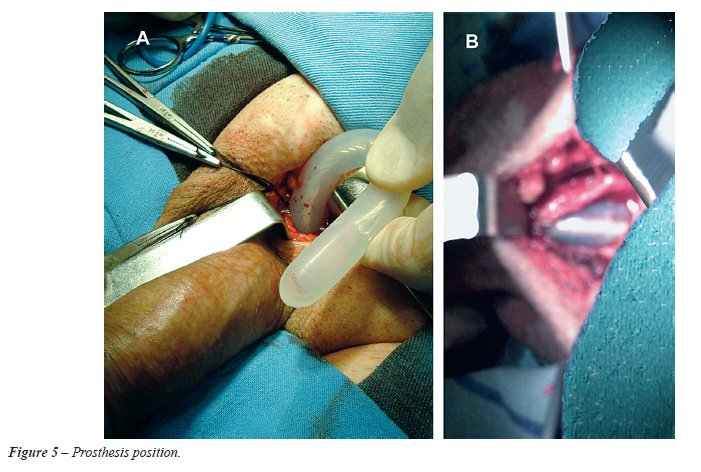
The synthesis of tunica albuginea is accomplished
with a 3-0 continuous absorbable synthetic suture. Hemostasis is reviewed
using diathermo-coagulation and the other incision planes are closed with
a 3-0 absorbable synthetic suture. Skin incision is closed in a continuous
or subcuticular 5-0 absorbable synthetic suture, in order to prevent the
patient’s discomfort when removing the suture (Figure-6A).
We only use an occlusive sterile surgical
paper tape, since the careful review of hemostasia does not require larger
compressive dressings that are, in fact, in this approach, of very little
help (Figure-6B).
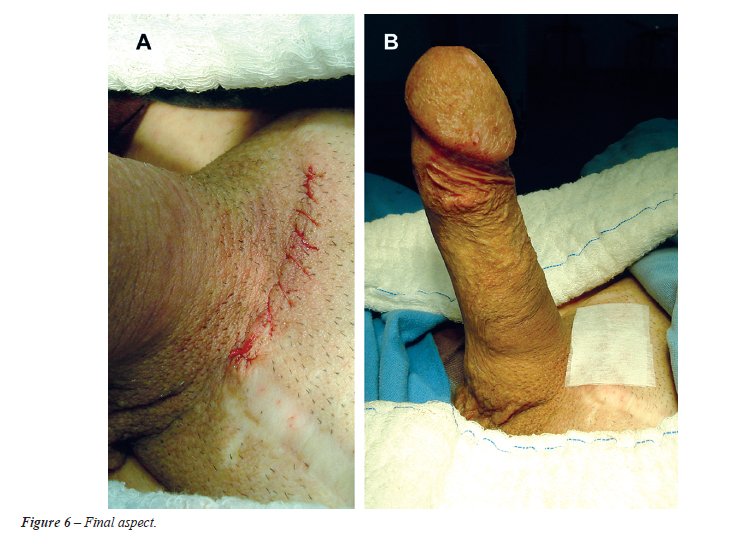
The proposed approach is being adopted in
both primary surgery and reoperations. In such cases, it is fully in accordance
with the basic principles of surgical interventions that recommend that
the approach adopted in a region already previously manipulated is, whenever
possible, through a fibrosis-free area. Accordingly, in the cases of revisions
or reimplants of malleable prostheses, where the first operation was done
through a penoscrotal approach, we consider the infrapubic approach to
be first option in another intervention.
COMMENTS
The
proposed approach as a technical option for the implant of malleable prostheses
finds support when we consider that despite the advances in the technology
of inflatable implants, the malleable prostheses are still used. This
fact is due not only to the technical facility of its implantation and
less risk of mechanical failure, but also mainly due to the much lower
surgical cost (1-6).
The infrapubic approach has therefore been
adopted in our hospital since 2007, also as a technical option for malleable
penile implants. Considering how simple this approach is, it has practically
totally substituted the longitudinal penoscrotal approach that we previously
used.
Taking the three-piece inflatable prostheses
as reference, today the penoscrotal approach is being widely used by surgeons,
tending to substitute the infrapubic incision used previously in such
procedures (2,12). However, in recent years, a minimally invasive technique
retrieves the infrapubic approach as an option for the three-piece inflatable
implants (8).
Similarly, with regard to malleable prostheses,
although a kind of infrapubic approach has been mentioned since 1976 by
Kelâmi, we can state that, at present, this type of access is seldom
addressed in medical literature, while the penoscrotal approach is more
often mentioned by the surgeons (1,2,7). Nevertheless, the infrapubic
approach is also an excellent technical option in these cases (13-16).
When implanting the inflatable prostheses,
the main benefit of the infrapubic approach is the possibility of direct
vision for implanting the liquid reservoir. Its disadvantages include
limited corpus cavernous exposure and difficulty in anchoring the pump
in the scrotum. Although lesions of the dorsal nerves of the penis seldom
occur during this procedure, it is a risk to be considered in the dissection
to expose the corpora cavernosa. The benefits of the penoscrotal approach
include better exposure of the corpus cavernous, impossibility of damaging
dorsal nerves of the penis and more facility in anchoring the inflating
pump. Its main disadvantages are more possibility of urethral lesion and
blindly implant of the reservoir in the retropubic space (17).
As occurs in inflatable implants, when implanting
malleable prostheses through the infrapubic access care must also be taken
regarding the possibility of lesion to the vascular-nervous bundle. On
the other hand, the approach through the dorsal surface of the corpora
cavernosa has a natural capacity for anatomical protection of the urethra,
not requiring transurethral catheterism. This benefit is of the utmost
importance when considering possible causes of per and postoperative morbidity
(18).
Accordingly, we can consider that the infrapubic
approach is an effective method and prevails as a technical option for
implanting malleable prostheses.
For obvious reasons, the benefits and disadvantages must be carefully
considered in obese patients with extensive adipose panicle in the region
to be cut.
CONFLICT OF INTEREST
None declared.
REFERENCES
- Henry GD: Historical review of penile prosthesis design and surgical techniques: part 1 of a three-part review series on penile prosthetic surgery. J Sex Med. 2009; 6: 675-81.
- Sadeghi-Nejad H: Penile prosthesis surgery: a review of prosthetic devices and associated complications. J Sex Med. 2007; 4: 296-309. Erratum in: J Sex Med. 2007; 4: 1520.
- Wilson SK, Delk JR, Salem EA, Cleves MA: Long-term survival of inflatable penile prostheses: single surgical group experience with 2,384 first-time implants spanning two decades. J Sex Med. 2007; 4: 1074-9.
- Lotan Y, Roehrborn CG, McConnell JD, Hendin BN: Factors influencing the outcomes of penile prosthesis surgery at a teaching institution. Urology. 2003; 62: 918-21.
- Dorflinger T, Bruskewitz R: AMS malleable penile prosthesis. Urology. 1986; 28: 480-5.
- Choi HK, Cho IR, Xin ZC: Ten years of experience with various penile prosthesis in Korean. Yonsei Med J. 1994; 35: 209-17.
- Glina S, Martins F: Técnicas de implante. In: Disfunção Sexual Masculina. São Paulo, Inst H Hellis.2002; pp. 259-62.
- Perito PE: Minimally invasive infrapubic inflatable penile implant. J Sex Med. 2008; 5: 27-30.
- Montague DK, Angermeier KW: Corporeal excavation: new technique for penile prosthesis implantation in men with severe corporeal fibrosis. Urology. 2006; 67: 1072-5.
- Shaeer O, Shaeer A: Corporoscopic excavation of the fibrosed corpora cavernosa for penile prosethesis implantation: optical corporotomy and trans-corporeal resection, Shaeer’s technique. J Sex Med. 2007; 4: 218-25.
- Shaeer O: Implantation of penile prosthesis in cases of corporeal fibrosis: modified Shaeer’s excavation technique. J Sex Med. 2008; 5: 2470-6.
- Candela JV, Hellstrom WJ: Three-piece inflatable penile prosthesis implantation: a comparison of the penoscrotal and infrapubic surgical approaches. J La State Med Soc. 1996; 148: 296-301.
- Kelâmi A: “Infrapubic” approach for small-carrion prosthesis in erectile impotence. Urology. 1976; 8: 164.
- Kelâmi A: Implantation of Small-Carrion prosthesis in the treatment of erectile impotence after priapism: difficulties and effects. Urol Int. 1985; 40: 343-6.
- Kelâmi A: Erictile impotence, small-carrion prosthesis and the ‘infrapubic’ approach. Eur Urol. 1977; 3: 299-302.
- Berg O, Leite A: Comparative study penoscrotal and infrapubic access routes for implanting malleable penile prostheses. J Sex Med. 2010: 7(Suppl 2): 51-68.
- Montague DK, Angermeir KW: Surgical approaches for penile prosthesis implantation: penoscrotal vs infrapubic. Int J Impot Res. 2003; 15(Suppl 5): S134-5.
- Anafarta K, Safak M, Bedük Y, Baltaci S, Aydos K: Clinical experience with inflatable and malleable penile implants in 104 patients. Urol Int. 1996; 56: 100-4.
____________________
Accepted after revision:
July 5, 2010
_______________________
Correspondence address:
Dr. Oswaldo Luiz Dias Berg
Rua São Clemente, 114 / 708
Rio de Janeiro, RJ, 22160-000, Brazil
Fax: + 55 21 2235-2828
E-mail: berg@vetor.com.br